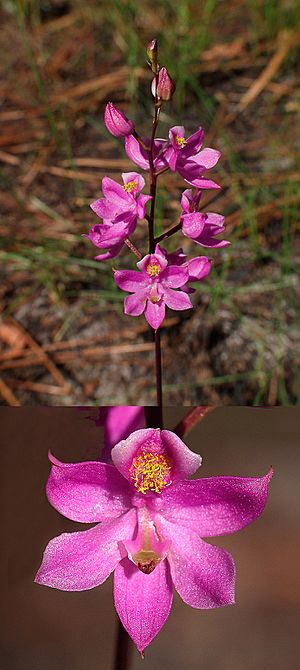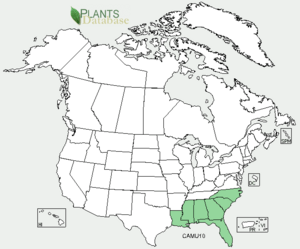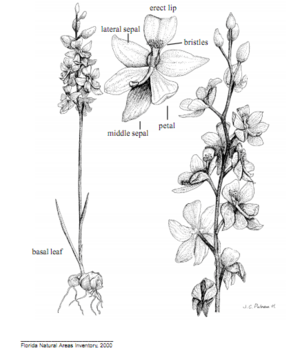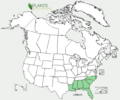Many-flowered grass-pink facts for kids
Quick facts for kids Many-flowered grass-pink |
|
|---|---|
 |
|
| Calopogon multiflorus flowers | |
| Scientific classification | |
| Genus: |
Calopogon
|
| Species: |
multiflorus
|
 |
|
| Synonyms | |
|
|
The many-flowered grass-pink, also known as Calopogon multiflorus, is a beautiful type of orchid. It's a plant that lives for many years (a perennial forb) and needs regular ground fires to keep its home healthy. The name Calopogon comes from Greek words meaning "beautiful beard," which describes the special bristles on the flower's lip.
Contents
Where It Lives
The many-flowered grass-pink orchid grows across the southeastern United States. You can find it mostly in Florida, but also in Alabama, Georgia, Mississippi, Louisiana, North Carolina, and South Carolina. Sadly, this orchid is now considered endangered in Florida and North Carolina.
Its Home and How It Lives
Calopogon multiflorus likes to grow in dry or slightly moist flatwoods. These areas often have wiregrass, longleaf pine trees, and saw palmetto plants. It also lives in sunny pine savannas that are flat or gently sloped. These longleaf pine savannas used to cover huge areas in southeastern North America. They naturally had fires at least once every ten years, which helped the plants grow.
However, many of these important habitats have been lost because of logging (cutting down trees) and efforts to stop natural fires. The soil where this orchid grows is usually sandy or loamy and a bit acidic. Other plants that often grow nearby include blackjack oak, inkberry, and different types of bluestem grass.
This orchid really needs fires to grow well. It's common for many plants in pine savannas to depend on regular fires. The Calopogon multiflorus is known to bloom about six to eight weeks after a fire. This is likely because the fire clears away other competing plants and adds helpful nutrients to the soil.
What It Looks Like and How It Grows
The many-flowered grass-pink has a dark purple stem where the flowers grow. It has a special underground stem called a corm that is forked. Its side petals are shaped a bit like a violin. The flower parts that protect the buds are small, about 0.3 to 0.8 centimeters long. When the flowers are fully open, they have a strong, pleasant smell.
In early spring, after the plant sprouts, one or sometimes two leaves appear. These leaves wrap around the flower stem. A single stem can have anywhere from one to fifteen flowers. When the flower buds are ready, they open very quickly, sometimes all within just two days! They stay open for a couple of days before wilting and falling off.
The many-flowered grass-pink usually blooms from March to May. In Louisiana, for example, it typically flowers in mid-April. This orchid grows best when it gets full sun or just a little bit of shade.
How It Gets Pollinated
This orchid is quite clever! It tricks bees into pollinating it by making them think there's lots of pollen available. The "beard" on the flower's lip looks like it's covered in pollen. When an insect lands on this beard, the lip swings down like a hinge. This movement places the insect's head and back onto the flower's column. If the insect doesn't have pollen yet, it picks up a load of pollinium (orchid pollen). If it already has pollen from another flower, the movement places that pollen onto the stigma, helping the plant make seeds.
Protecting This Orchid
Even though this orchid used to be found in many places, it's now rare. This is mainly because people have stopped natural fires and changed its habitat into pine plantations.
One important way to protect this species is to have controlled fires in the flatwoods every 2–3 years during the growing season. It's also important to protect these areas from activities that disturb the soil and water, like clear-cutting forests or draining wetlands.
Images for kids
See also
 In Spanish: Calopogon multiflorus para niños
In Spanish: Calopogon multiflorus para niños




